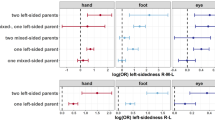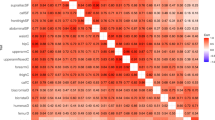Abstract
Nondirectional asymmetry of paired morphological structures may reflect a decrease in developmental buffering, thereby increasing susceptibility to developmental noise. The palmara-b ridge count, measuring the size of the second interdigital area of the hand, yields a convenient and promising index of developmental canalization in normal adults. We constrasted 28 monozygotic twin pairs in which one or both members exhibiteda-b ridge-count asymmetry, with 32 paris exhibiting little or no left-right asymmetry. The asymmetric paris were significantly less similar for many Minnesota Multiphasic Personality Inventory (MMPI) scales, and total variances of these scales tended to be greater among individual twins with extreme left-right asymmetries. The results suggest that an asymmetrica-b ridge count may identify individuals who are poorly buffered from developmental noise. But the asymmetry may arise from the twinning process itself, and our buffering hypothesis remains to be tested in twins of known placental type and in longitudinal instability of asymmetric nontwins.
Similar content being viewed by others
References
Adams, M. S., and Niwsander, J. S. (1967). Developmental “noise” and a congenital malformation.Genet Res. 103:313–317.
Bulmer, M. G. (1970).The Biology of Twinning in Man, Oxford University Press, London.
Christian, J. C., Kang, K. W., and Norton, J. A. (1974). Choice of an estimate of genetic variance from twin data.Am. J. Hum. Genet. 26:154–161.
Costa, P. T., Jr., Zonderman, A. B., McCrae, R. R., and Williams, R. B., Jr. (1985). Content and comprehensiveness in the MMPI: An item factor analysis in a normal adult sample.J. Personal. Soc. Psychol. 48:925–933.
Cummins, H. (1929). The topographic history of the volar pads (walking pads; tastballen) in the human embryo.Contrib. Embryol. 20:103–126.
Cummins, H., and Midlo, C. (1976).Finger Prints, Palms and Soles, Research Publ., South Berlin, Mass.
Floris, G., and Sanna, E. (1982). Thea-b ridge count.Bull. Int. Dermatoglyph. Assoc. 10(1):16–19.
Hale, A. R. (1952). Morphogenesis of volar skin in the human fetus.Am. J. Anat. 91:147–173.
Henderson, N. D. (1967). Prior treatment effects on open field behavior of mice—a genetic analysis.Anim. Behav. 15:364–376.
Heterington, E. M., and Parke, R. D. (1979).Child Psychology: A Contemporary Viewpoint, 2nd ed., McGraw-Hill, New York.
Holt, S. B. (1968).The Genetics of Dermal Ridges, Thomas, Springfield, Ill.
Jantz, R. L., and Webb, R. S. (1980). Dermatoglyphic asymmetry as a measure of canalization.Ann. Hum. Biol. 7:489–493.
Kindred, B. (1967). Selection for canalization in mice.Genetics 55:635–644.
Knussmann, R. (1969). Biostatische familienuntersuchungen zur hautleistenvariabilitat des menschen.Humangenetik 8:206–216.
Leon, G. R., Gillum, B., Gillum, R., and Gouze, M. (1979). Personality stability and change over a 30 year period—Middle age to old age.J. Consult. Clin. Psychol. 47:517–524.
Lin, P. M., Crawford, M. H., and Oronzi, M. (1979). Universals in dermatoglyphics.Birth Defects Orig. Art. Ser. 15(6):63–84.
MacAndrew, C. (1965). The differentiations of male alcoholic outpatients from non-alcoholic psychiatric outpatients by means of MMPI.Q. J. Stud. Alcohol 26:238–246.
Mather, K. (1953). Genetical control of stability in development.Heredity 7:297–336.
Mulvihill, J. J., and Smith, D. W. (1969). The genesis of dermatoglyphics.J. Pediat. 75:579–589.
Oliveira, L. L. (1980).Dermatoglyphics of University of Tennessee Students: Effects of Parental Age and Birth Order, Thesis, University of Tennessee [(1978).Bull. Int. Dermatoglyph. Assoc. 8(2):78 (abstr.)].
Penrose, L. S. (1954). The distal triradius t on the hands of parents and sibs of mongol imbeciles.Ann. Hum. Genet. 19:10–38.
Pogue-Geile, M. F., and Rose, R. J. (1985). Developmental genetic studies of adult personality.Dev. Psychol. 21:547–557.
Reed, T., Uchida, I. A., Norton, J. A., Jr., and Christian, J. C. (1978). Comparisons of dermatoglyphic patterns in monochorionic and dichorionic monozygotic twins.Am. J. Hum. Genet. 30:383–391.
Reed, T., Norton, J. A., Jr., and Christian, J. C. (1979). Dermatoglyphic pattern factors.Birth Defect Orig. Art. Ser. 15(6):85–93.
Rose, R. J. (1982). Variation in adult personality: Uniformly modesth 2? No common environment? Is that all there is?Behav. Genet. 12:595 (abstr.).
Rose, R. J. (1985). Familial determinants of the MacAndrew Scale.Alcohol. Clin. Exp. Res. 9:188 (abstr.).
Rose, R. J., Buder, J. R., and Miller, J. Z. (1981). Behavioral correlates of dermatoglyphic discordance and asymmetry in MZ co-twins.Behav. Genet. 11:610–611 (abstr.).
Samandari, F. (1973). Embryonale bildung der hautleisten im bereich des proximalen handtellers.Z. Morphol. Anthropol. 65:218–229.
Stein, K. B. (1968). The TSC scales: The outcome of a cluster analyses of the 550 MMPI items. In McReynolds, P. (ed.),Advances in Psychological Assessment, Vol. 1. Science and Behavior Books, Palo Alto, Calif.
Thompson, W. R. (1968). Genetics and social behavior. In Glass, D. C. (ed.),Biology and Behavior: Genetics, Rockefeller University Press/Russell Sage Foundation, New York, pp. 79–101.
Waddington, C. H. (1942). Canalization of development and the inheritance of acquired characters.Nature 150:563–565.
Waddington, C. H. (1957).The Strategy of the Genes, Macmillan, New York.
Welsh, G. S. (1965). MMPI profiles and factor scales A and R.J. Clin. Psychol. 21:43–47.
Wiggins, J. S. (1966). Substantive dimensions of self-report in the MMPI item pool.Psychol. Monogr. 80:Whole No. 630.
Woolf, C. M., and Gianas, A. D. (1976). Congenital cleft lip and fluctuating dermatoglyphic asymmetry.Am. J. Hum. Genet. 28:400–403.
Woolf, C. M., and Gianas, A. D. (1977). A study of fluctuating dermatoglyphic asymmetry in the sibs and parents of cleft lip propositi.Am. J. Hum. Genet. 29:503–507.
Author information
Authors and Affiliations
Rights and permissions
About this article
Cite this article
Rose, R.J., Reed, T. & Bogle, A. Asymmetry ofa-b ridge count and behavioral discordance of monozygotic twins. Behav Genet 17, 125–140 (1987). https://doi.org/10.1007/BF01065992
Received:
Accepted:
Issue Date:
DOI: https://doi.org/10.1007/BF01065992




